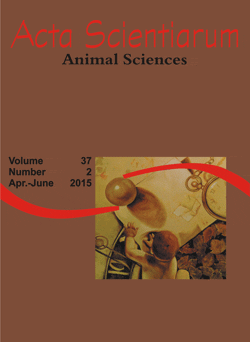<b>Chemical and Fatty acid composition of different cuts cooked or uncooked from yearling bulls fed oil sources
Abstract
This study evaluated the chemical and lipid composition of uncooked or cooked loin (Longissimus thoracis) and rump (Biceps femoris) in samples of 2.54 cm thick from 35 carcasses of Nellore young bulls finished in feedlot for 96 days and slaughtered at an average weight of 532.17 ± 30.25 kg and 24 months of age. The rump had the lowest level of protein and ash (18.57 and 0.90%, respectively) and the highest level of ether extract compared to loin (3.37 and 1.90%, respectively). Higher levels of cholesterol were found in rump compared to loin (40.91 e 30.93 mg 100 g-1, respectively). The uncooked loin showed lower content of saturated fatty acids and higher content of polyunsaturated fatty acids. The best values for the omega-6: omega-3 ratio was observed in the uncooked beef. In the present study, the loin was healthier due to the higher amount of polyunsaturated fatty acids compared to rump. Cooking the meat decreases the levels of polyunsaturated fatty acids, omega-3, omega-6 and the omega-6: omega-3 ratio.
Downloads
DECLARATION OF ORIGINALITY AND COPYRIGHTS
- I Declare that current article is original and has not been submitted for publication, in part or in whole, to any other national or international journal.
The copyrights belong exclusively to the authors. Published content is licensed under Creative Commons Attribution 4.0 (CC BY 4.0) guidelines, which allows sharing (copy and distribution of the material in any medium or format) and adaptation (remix, transform, and build upon the material) for any purpose, even commercially, under the terms of attribution.
Read this link for further information on how to use CC BY 4.0 properly.








































